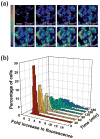New approaches for sensing metabolites and proteins in live cells using RNA
- PMID: 23746618
- PMCID: PMC3742595
- DOI: 10.1016/j.cbpa.2013.05.014
New approaches for sensing metabolites and proteins in live cells using RNA
Abstract
Tools to study the abundance, distribution, and flux of intracellular molecules are crucial for understanding cellular signaling and physiology. Although powerful, the current FRET-based technology for imaging cellular metabolites is not easily generalizable. Thus, new platforms for generating genetically encoded sensors are needed. We recently developed a new class of biosensors on the basis of Spinach, an RNA mimic of GFP. In this case, RNA aptamers against a target ligand are modularly fused to Spinach that substantially induce Spinach fluorescence in the presence of ligand. We have used this approach to detect metabolites and proteins both in vitro and in living bacteria, thus providing an alternative to FRET-based sensors and a generalizable approach for generating fluorescent sensors to any ligand of interest.
Copyright © 2013 Elsevier Ltd. All rights reserved.
Figures



Similar articles
-
RNA-Based Fluorescent Biosensors for Detecting Metabolites in vitro and in Living Cells.Adv Pharmacol. 2018;82:187-203. doi: 10.1016/bs.apha.2017.09.005. Epub 2017 Oct 25. Adv Pharmacol. 2018. PMID: 29413520 Review.
-
Live Cell Imaging Using Riboswitch-Spinach tRNA Fusions as Metabolite-Sensing Fluorescent Biosensors.Methods Mol Biol. 2015;1316:87-103. doi: 10.1007/978-1-4939-2730-2_8. Methods Mol Biol. 2015. PMID: 25967055
-
Using Spinach-based sensors for fluorescence imaging of intracellular metabolites and proteins in living bacteria.Nat Protoc. 2014 Jan;9(1):146-55. doi: 10.1038/nprot.2014.001. Epub 2013 Dec 19. Nat Protoc. 2014. PMID: 24356773 Free PMC article.
-
Tandem Spinach Array for mRNA Imaging in Living Bacterial Cells.Sci Rep. 2015 Nov 27;5:17295. doi: 10.1038/srep17295. Sci Rep. 2015. PMID: 26612428 Free PMC article.
-
Imaging and tracing of intracellular metabolites utilizing genetically encoded fluorescent biosensors.Biotechnol J. 2013 Nov;8(11):1280-91. doi: 10.1002/biot.201300001. Epub 2013 Sep 25. Biotechnol J. 2013. PMID: 24591186 Review.
Cited by
-
Quantitative imaging of glutathione in live cells using a reversible reaction-based ratiometric fluorescent probe.ACS Chem Biol. 2015 Mar 20;10(3):864-74. doi: 10.1021/cb500986w. Epub 2015 Jan 6. ACS Chem Biol. 2015. PMID: 25531746 Free PMC article.
-
Development of a wavelength-shifting fluorescent module for the adenosine aptamer using photostable cyanine dyes.ChemistryOpen. 2015 Apr;4(2):92-6. doi: 10.1002/open.201402137. Epub 2015 Feb 12. ChemistryOpen. 2015. PMID: 25969803 Free PMC article.
-
Probing molecular choreography through single-molecule biochemistry.Nat Struct Mol Biol. 2015 Dec;22(12):948-52. doi: 10.1038/nsmb.3119. Nat Struct Mol Biol. 2015. PMID: 26643847
-
Understanding the photophysics of the spinach-DFHBI RNA aptamer-fluorogen complex to improve live-cell RNA imaging.J Am Chem Soc. 2013 Dec 18;135(50):19033-8. doi: 10.1021/ja411060p. Epub 2013 Dec 10. J Am Chem Soc. 2013. PMID: 24286188 Free PMC article.
-
A Critical and Comparative Review of Fluorescent Tools for Live-Cell Imaging.Annu Rev Physiol. 2017 Feb 10;79:93-117. doi: 10.1146/annurev-physiol-022516-034055. Epub 2016 Nov 16. Annu Rev Physiol. 2017. PMID: 27860833 Free PMC article. Review.
References
-
- Zhang J, Campbell RE, Ting AY, Tsien RY. Creating new fluorescent probes for cell biology. Nat Rev Mol Cell Biol. 2002;3:906–918. An important review summarizing the generation of the first fluorescent protein based FRET sensors. - PubMed
-
- Lakowicz JR. Principles of fluorescence spectroscopy. 3. New York: Springer; 2006. p. xxvi.p. 954.
-
- Tsien RY. The green fluorescent protein. Annu Rev Biochem. 1998;67:509–544. - PubMed
Publication types
MeSH terms
Substances
Grants and funding
LinkOut - more resources
Full Text Sources
Other Literature Sources

